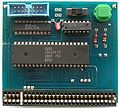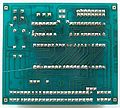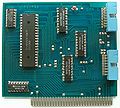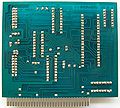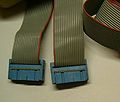Difference between revisions of "PDS development system"
(→Pictures) |
(→Pictures) |
||
| Line 54: | Line 54: | ||
</gallery> | </gallery> | ||
| − | Note that the photos seem to be showing a spanish remake, not the origial hardware (as indicated by the "P DE FRANCISCO" text on the solder side). | + | Note that the photos seem to be showing a spanish remake, not the origial hardware (as indicated by the "P DE FRANCISCO" text on the solder side). The two schematics are a "remake-of-the-remake" (ie. the PCBs seem be authentic old hardware, the latest YYWW year/week datestamp on the chips is from 1989. The schematics were drawn at a later time, when reverse engieering how the PCBs worked). |
== Info from Andy Glaister == | == Info from Andy Glaister == | ||
Revision as of 08:52, 12 April 2010
PDS is an acronym for "Programmers Development System" and is a development system made by Andy Glaister. The system comprised an "Apricot PC" (an early PC), assembler, debugger, editor, profile, graphics tool and hardware to connect to a target computer. A company called "Programmers Development Systems Ltd" or "PD Systems" sold it.
The system made it easy to develop for computers like the Amstrad CPC, C64, MSX, and ZX Spectrum. The code was written on the PC and transferred through the hardware interface to the target computer.
The target computer ran a program which waited for PDS to send it instructions.
Contents
Technical
Uses port FBEC-FBEF.
FBEC PDS Z80 PIO Port A Data (8bit data to/from PC) FBED PDS Z80 PIO Port B Data (handshake to/from PC) FBEE PDS Z80 PIO Port A Control FBEF PDS Z80 PIO Port B Control
The CPC interface connects to Expansion Port, and contains a Z80 PIO chip, and 74LS245, 74LS04, 74LS32 logic chips, and a Reset button. And a 2x8pin connector, for connecting to PC via 16pin flat-cable.
The PC interface connects to ISA bus, and contains a 8255 PPI chip, five logic chips, and two 2x8pin connectors, allowing to connect to up to two slave computers.
Not 100% sure if above describes the original PC/CPC interfaces - or if that are homebrew remakes (?)
Disassembling games (see list below), gives confliction port addresses (unclear which are correct, might be also an older or newer PDS hardware version),
FBEC - unknown (maybe configuration, or maybe REQUEST to PC) FBED - data to PC (used in Last V8) FBEE - bit0 = CLK signal from PC FBEF - data from PC
CPC Games that contain PDS code
Normally, the PDS related code wasn't included in release versions, however, some release versions do still contain some (unused) code fragments that access some Ports at FBEC-FBEF:
- Gremlins (spanish version)
- Last V8
- Robin of Sherwood
- Seablood
The code fragments seem to be related to data transfers - whether or not they are using the PDS hardware, or other similar hardware isn't confirmed.
Pictures
Note that the photos seem to be showing a spanish remake, not the origial hardware (as indicated by the "P DE FRANCISCO" text on the solder side). The two schematics are a "remake-of-the-remake" (ie. the PCBs seem be authentic old hardware, the latest YYWW year/week datestamp on the chips is from 1989. The schematics were drawn at a later time, when reverse engieering how the PCBs worked).
Info from Andy Glaister
"During the rest of the 1980's I started working on a development system as typing in hex using a two line basic program was becoming more and more difficult. This was developed on one of the first IBM PC clones from England - the 'Apricot PC'. This was an extremely well designed machine and actually had some advantages over the early IBM PC's - namely a 960K memory limit, a separate LCD in the keyboard and great hardware and software manuals. The assembler, editor, debugger, profiler, graphics tool and hardware card to connect to C64's, ZX Spectrums, Amstrads, C16's etc... became really popular with first my friends and then more and more developers. I formed a company called 'Programmers Development Systems Ltd.' or PD Systems with Jacqui Lyons (of Marjacq) and Fouad Katan (of Bits) and for the remainder of the 1980's and early 90's we sold about 500 systems to pretty much all the game development companies in England. Many of the people who bought these systems would never have used the PC for anything else, so it was quite a large investment at the time. It's difficult to find information on PDS these days, I have found a couple of links to companies and individuals who mention PDS: http://tacgr.emuunlim.com/interviews/interviews.php?interview=1, http://www.blitzgames.com/olivertwins/earlyyearsp2.htm"
Manual
- Media:The PDS Z80 Manual.pdf - Describes Z80 Assembler, Debugger, and Transfer Protocol


